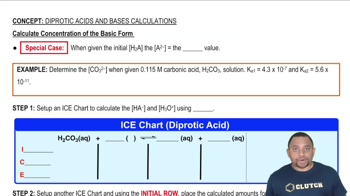A 0.831-g sample of SO3 is placed in a 1.00-L container and heated to 1100 K. The SO3 decomposes to SO2 and O2: 2SO3(𝑔) ⇌ 2 SO2(𝑔) + O2(𝑔) At equilibrium, the total pressure in the container is 1.300 atm. Find the values of 𝐾𝑝 and 𝐾𝑐 for this reaction at 1100 K.
When 1.50 mol CO2 and 1.50 mol H2 are placed in a 3.00-L container at 395 _x001F_C, the following reaction occurs: CO2(g) + H2(g) ⇌ CO(g) + H2O(g). If Kc = 0.802, what are the concentrations of each substance in the equilibrium mixture?
 Verified step by step guidance
Verified step by step guidanceKey Concepts
Equilibrium Constant (Kc)

Concentration Calculations

Le Chatelier's Principle

Nitric oxide (NO) reacts readily with chlorine gas as follows: 2 NO(𝑔) + Cl2(𝑔) ⇌ 2 NOCl(𝑔) At 700 K, the equilibrium constant Kp for this reaction is 0.26. Predict the behavior of each of the following mixtures at this temperature and indicate whether or not the mixtures are at equilibrium. If not, state whether the mixture will need to produce more products or reactants to reach equilibrium.
(a) PNO = 0.15 atm, PCl2 = 0.31 atm, PNOCl = 0.11 atm
(b) PNO = 0.12 atm, PCl2 = 0.10 atm, PNOCl = 0.050 atm
(c) PNO = 0.15 atm, PCl2 = 0.20 atm, PNOCl = 5.10 × 10-3 atm
At 900 °C, 𝐾𝑐 = 0.0108 for the reaction
CaCO3(𝑠) ⇌ CaO(𝑠) + CO2(𝑔)
A mixture of CaCO3, CaO, and CO2 is placed in a 10.0-L vessel at 900°C. For the following mixtures, will the amount of CaCO3 increase, decrease, or remain the same as the system approaches equilibrium?
(a) 15.0 g CaCO3, 15.0 g CaO, and 4.25 g CO2
(b) 2.50 g CaCO3, 25.0 g CaO, and 5.66 g CO2
(c) 30.5 g CaCO3, 25.5 g CaO, and 6.48 g CO2
The equilibrium constant constant 𝐾𝑐 for C(𝑠) + CO2(𝑔) ⇌ 2 CO(𝑔) is 1.9 at 1000 K and 0.133 at 298 K. (a) If excess C is allowed to react with 25.0 g of CO2 in a 3.00-L vessel at 1000 K, how many grams of CO are produced? (b) If excess C is allowed to react with 25.0 g of CO2 in a 3.00-L vessel at 1000 K, how many grams of C are consumed?
